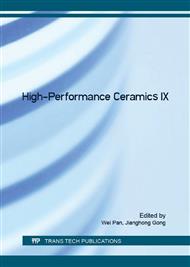p.576
p.581
p.586
p.591
p.595
p.599
p.604
p.608
p.612
Effect of Particle Size Distribution of Raw Materials on Properties of Magnesia-Alumina Refractory
Abstract:
Starting from different sizes of magnesia and bauxitewith sodium hexametaphosphate as anchoring agent, specimens obtained by suppression were sintered at 1500°C and 1550°C and heat preservation for 3h in the electric hearth furnace, respectively. The effect of particle size distribution of magnesia and bauxite on the properties of magnesia-alumina refractory materials was investigated. The composition of magnesia-alumina refractory which consists of various particle size distributions was determined, according to Andreasen packing model, with distribution coefficient (q) of 0.15, 0.20, 0.25, 0.30, 0.35, 0.40 and 0.50. The fractographs of the specimen were observed by scanning electron microscopy. The linear rate of change, apparent porosity, bulk density and crushing strength of these specimens were studied. The results showed: a crushing strength of 52.39 MPa, an apparent porosity value of 15.55% and a bulk density value of 2.91 g/cm3 were obtained via a particle size distribution coefficient of 0.30 at 1550°C. Simultaneously, the refractory materials had small linear rate of change.
Info:
Periodical:
Pages:
595-598
Citation:
Online since:
July 2016
Authors:
Price:
Сopyright:
© 2016 Trans Tech Publications Ltd. All Rights Reserved
Share:
Citation:


